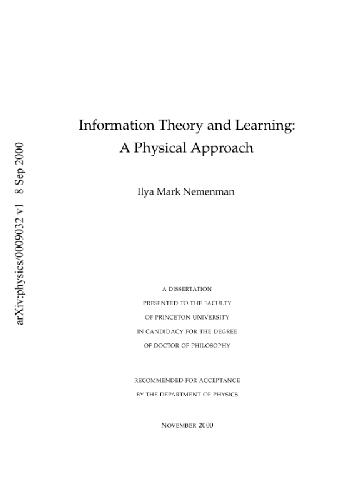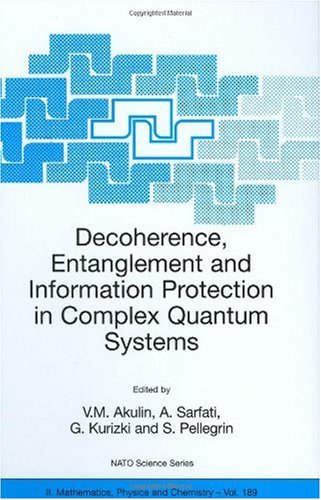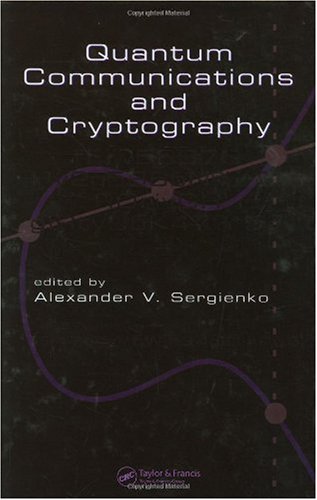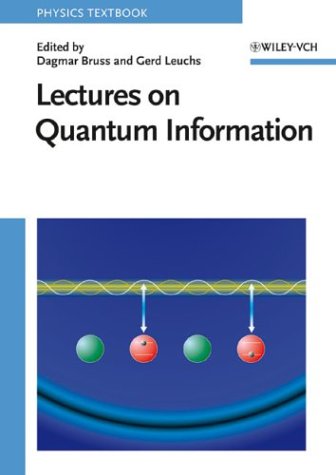A. F. J. Levi9780521860963, 0521860962
Table of contents :
Cover……Page 1
Half-title……Page 3
Title……Page 5
Copyright……Page 6
Dedication……Page 7
Contents……Page 9
Preface to the first edition……Page 15
Preface to the second edition……Page 17
MATLAB® programs……Page 18
1.1 Motivation……Page 19
1.2.1 Introduction……Page 22
1.2.2 The one-dimensional simple harmonic oscillator……Page 25
1.2.3 Harmonic oscillation of a diatomic molecule……Page 28
1.2.4 The monatomic linear chain……Page 31
1.2.5 The diatomic linear chain……Page 33
1.3.1 Electrostatics……Page 36
1.3.1.1 The parallel plate capacitor……Page 38
1.3.1.2 The coulomb blockade……Page 40
1.3.2 Electrodynamics……Page 42
1.3.2.1 Light propagation in a dielectric medium……Page 45
1.3.2.2 Power and momentum in an electromagnetic wave……Page 50
1.3.2.4 Dipole radiation……Page 53
1.4 Example exercises……Page 57
1.5 Problems……Page 71
2.1 Introduction……Page 75
2.1.1 Diffraction and interference of light……Page 76
2.1.2 Black-body radiation and evidence for quantization of light……Page 80
2.1.3 Photoelectric effect and the photon particle……Page 82
2.1.4 Secure quantum communication……Page 84
2.1.5 The link between quantization of photons and other particles……Page 88
2.1.6 Diffraction and interference of electrons……Page 89
2.1.7 When is a particle a wave?……Page 90
2.2 The Schrödinger wave equation……Page 91
2.2.1 The wave function description of an electron in free space……Page 97
2.2.2 The electron wave packet and dispersion……Page 98
2.2.3 The hydrogen atom……Page 101
2.2.3.2 Calculation of energy difference between electron orbits in hydrogen……Page 104
2.2.4 Periodic table of elements……Page 107
2.2.5.2 Two-dimensional square lattice……Page 111
2.2.5.4 Cubic lattices in three dimensions……Page 112
2.2.5.5 The reciprocal lattice……Page 113
2.2.6 Electronic properties of bulk semiconductors and heterostructures……Page 114
2.2.6.1 The heterostructure diode……Page 119
2.3 Example exercises……Page 121
2.4 Problems……Page 132
3.1 Introduction……Page 135
3.1.1 The effect of discontinuity in the wave function and its slope……Page 136
3.2 Wave function normalization and completeness……Page 139
3.3 Inversion symmetry in the potential……Page 140
3.3.1 One-dimensional rectangular potential well with infinite barrier energy……Page 141
3.4 Numerical solution of the Schrödinger equation……Page 144
3.5 Current flow……Page 146
3.5.1 Current in a rectangular potential well with infinite barrier energy……Page 147
3.6.1 Bound states in three dimensions and degeneracy of eigenvalues……Page 149
3.7 Symmetric finite-barrier potential……Page 151
3.7.1 Calculation of bound states in a symmetric finite-barrier potential……Page 153
3.8 Transmission and reflection of unbound states……Page 155
3.8.1 Scattering from a potential step when m1 = m2……Page 156
3.8.2 Scattering from a potential step when m1 = m2……Page 158
3.8.3 Probability current density for scattering at a step……Page 159
3.8.4 Impedance matching for unity transmission across a potential step……Page 160
3.9 Particle tunneling……Page 163
3.9.1 Electron tunneling limit to reduction in size of CMOS transistors……Page 167
3.10 The nonequilibrium electron transistor……Page 168
3.11 Example exercises……Page 173
3.12 Problems……Page 186
4.1 Introduction……Page 189
4.2 The propagation matrix method……Page 190
Part I: The step propagation matrix……Page 191
Part II: The propagation between steps……Page 193
Part IV: Propagation through an arbitrary series of step potentials……Page 194
4.3 Program to calculate transmission probability……Page 195
4.4 Time-reversal symmetry……Page 196
4.5 Current conservation and the propagation matrix……Page 198
4.6.1 Transmission probability for a rectangular potential barrier……Page 200
4.6.1.1 Transmission when E ≥ V0……Page 202
4.6.2 Transmission as a function of energy……Page 203
4.6.3 Transmission resonances……Page 204
4.7 Resonant tunneling……Page 206
4.7.1 Heterostructure bipolar transistor with resonant tunnel-barrier……Page 208
4.7.2 Resonant tunneling between two quantum wells……Page 210
4.8 The potential barrier in the delta function limit……Page 215
4.9 Energy bands in a periodic potential……Page 217
4.9.1 Bloch’s Theorem……Page 218
4.9.2 The propagation matrix applied to a periodic potential……Page 219
4.9.3 The tight binding approximation……Page 225
4.9.4 Crystal momentum and effective electron mass……Page 227
4.9.4.1 The band structure of GaAs……Page 230
4.10 Other engineering applications……Page 231
4.11 The WKB approximation……Page 232
4.11.1 Tunneling through a high-energy barrier of finite width……Page 233
4.12 Example exercises……Page 235
4.13 Problems……Page 252
5.1.1.3 Postulate 3……Page 256
5.2 One-particle wave function space……Page 257
5.3 Properties of linear operators……Page 258
5.3.2 Properties of Hermitian operators……Page 259
5.3.4 Completeness of eigenfunctions……Page 261
5.3.5 Commutator algebra……Page 262
5.4 Dirac notation……Page 263
5.5 Measurement of real numbers……Page 264
5.5.1 Expectation value of an operator……Page 265
5.5.2.1 Time dependence of position operator of particle moving in free space……Page 266
5.5.3 Uncertainty of expectation value……Page 267
5.5.3.1 Uncertainty in expectation value of a particle confined by a one-dimensional, infinite, rectangular potential……Page 268
5.5.4 The generalized uncertainty relation……Page 271
5.6 The no cloning theorem……Page 273
5.7.1 Density of electron states……Page 274
5.7.1.1 Quantum conductance……Page 279
5.7.2 Calculating density of states from a dispersion relation……Page 281
5.7.3 Density of photon states……Page 282
5.8 Example exercises……Page 284
5.9 Problems……Page 295
6.1 The harmonic oscillator potential……Page 298
6.2 Creation and annihilation operators……Page 300
6.2.1 The ground state of the harmonic oscillator……Page 302
6.2.1.1 Uncertainty in position and momentum for the harmonic oscillator in the ground state……Page 304
6.2.2 Excited states of the harmonic oscillator and normalization of eigenstates……Page 305
6.2.2.1 Matrix elements……Page 308
6.3 The harmonic oscillator wave functions……Page 309
6.3.1 The classical turning point of the harmonic oscillator……Page 313
6.4 Time dependence……Page 316
6.4.2 Measurement of a superposition state……Page 318
6.4.3 Time dependence of creation and annihilation operators……Page 319
6.4.3.1 Charged particle in a harmonic potential subject to a constant electric field E……Page 320
6.5 Quantization of electromagnetic fields……Page 323
6.5.2 Quantization of an electrical resonator……Page 324
6.6 Quantization of lattice vibrations……Page 325
6.7 Quantization of mechanical vibrations……Page 326
6.8 Example exercises……Page 327
6.9 Problems……Page 341
7.1 Introduction……Page 344
7.1.1 The symmetry of indistinguishable particles……Page 345
7.1.1.1 Fermion creation and annihilation operators……Page 347
7.2 Fermi–Dirac distribution and chemical potential……Page 352
7.2.1 Writing a computer program to calculate the chemical potential……Page 355
7.2.2 Writing a computer program to plot the Fermi–Dirac distribution……Page 356
7.2.3 Fermi–Dirac distribution function and thermal equilibrium statistics……Page 357
7.3 The Bose–Einstein distribution function……Page 360
7.4 Example exercises……Page 361
7.5 Problems……Page 369
8.1 Introduction……Page 371
8.1.1 An abrupt change in potential……Page 372
8.1.2 Time-dependent change in potential……Page 374
8.2 First-order time-dependent perturbation……Page 377
8.2.1 Charged particle in a harmonic potential……Page 378
8.3 Fermi’s golden rule……Page 381
8.4 Elastic scattering from ionized impurities……Page 384
8.4.1 The coulomb potential……Page 387
8.4.1.1 Elastic scattering of electrons by ionized impurities in GaAs……Page 388
8.4.1.3 Calculating electron mean free path……Page 390
8.4.1.4 Calculating mobility and conductivity……Page 392
8.4.2.1 Calculating the screened potential in real space……Page 393
8.4.2.2 Calculating the screened potential and dielectric function in wave vector space……Page 396
8.4.2.3 Using the Thomas–Fermi dielectric function to calculate elastic, ionized-impurity, electron scattering in GaAs……Page 399
8.4.2.4 Elastic electron scattering in the limit of small initial velocity……Page 400
8.4.2.5 Elastic electron scattering in the limit of large initial velocity……Page 401
8.5.1 Density of optical modes in three-dimensions……Page 402
8.5.4 Fermi’s golden rule for stimulated optical transitions……Page 403
8.5.5 The Einstein and coefficients……Page 405
8.5.5.2 Dipole selection rules for optical transitions……Page 407
8.5.5.3 Spontaneous emission lifetime of an electron in a one-dimensional, rectangular potential well with infinite barrier energy…….Page 408
8.6 Example exercises……Page 411
8.7 Problems……Page 425
9.1 Introduction……Page 430
9.2 Spontaneous and stimulated emission……Page 431
9.2.1 Absorption and its relation to spontaneous emission……Page 434
9.3 Optical transitions using Fermi’s golden rule……Page 437
9.3.1 Optical gain in the presence of electron scattering……Page 438
9.4.1 The optical cavity……Page 440
9.4.1.1 Longitudinal resonances in the z direction……Page 441
9.4.1.2 Mode profile in an index-guided slab waveguide……Page 444
9.4.2 Mirror loss and photon lifetime……Page 446
9.4.3 The Fabry–Perot laser diode……Page 447
9.4.4 Semiconductor laser diode rate equations……Page 448
9.5 Numerical method of solving rate equations……Page 452
9.5.1 The Runge–Kutta method……Page 453
9.5.2 Large-signal transient response……Page 455
9.5.3 Cavity formation……Page 456
9.6 Noise in laser diode light emission……Page 458
9.8 Example exercises……Page 461
9.9 Problems……Page 467
10.1 Introduction……Page 468
10.2 Time-independent nondegenerate perturbation……Page 469
10.2.1 The first-order correction……Page 470
10.2.2 The second-order correction……Page 471
10.2.2.2 Second-order coefficients ak (2)……Page 472
10.2.3 Harmonic oscillator subject to perturbing potential in x……Page 474
10.2.4 Harmonic oscillator subject to perturbing potential in x2……Page 476
10.2.5 Harmonic oscillator subject to perturbing potential in x3……Page 477
10.3 Time-independent degenerate perturbation……Page 479
10.3.2 Matrix method……Page 480
10.3.2.1 Matrix method for two states……Page 481
10.3.3 The two-dimensional harmonic oscillator subject to perturbation in xy……Page 483
10.3.4 Perturbation of two-dimensional potential with infinite barrier energy……Page 485
10.4 Example exercises……Page 489
10.5 Problems……Page 500
11.1.1 Classical angular momentum……Page 503
11.2 The angular momentum operator……Page 505
11.2.1 Eigenvalues of angular momentum operators Lz and L2……Page 507
11.2.2 Geometrical representation……Page 509
11.2.3 Spherical coordinates and spherical harmonics……Page 510
11.2.4 The rigid rotator……Page 516
11.3 The hydrogen atom……Page 517
11.3.1 Eigenstates and eigenvalues of the hydrogen atom……Page 518
11.3.2 Hydrogenic atom wave functions……Page 526
11.3.3 Electromagnetic radiation……Page 527
11.3.3.1 No eigenstate radiation……Page 528
11.3.3.3 Selection rules for dipole radiation……Page 529
11.3.3.4 Hydrogen 2p to 1s transition……Page 532
11.3.4 Fine structure of the hydrogen atom and electron spin……Page 533
11.4 Hybridization……Page 534
11.5 Example exercises……Page 535
11.6 Problems……Page 547
A.1 Constants in quantum mechanics……Page 550
A.2 The MKS and SI units of measurement……Page 551
A.3 Other units of measurement……Page 553
A.4 Use of quantum-mechanical effects to define units of measure……Page 554
B.1 Coordinates……Page 555
B.2 Useful trigonometric relations……Page 556
B.3 Mensuration……Page 557
C.1 Factorials and series expansions……Page 558
C.2 Differentiation……Page 559
C.3 Integration……Page 560
C.6 Fourier integral……Page 562
C.8 Correlation functions……Page 563
D.1 Matrices and determinants……Page 564
E.1 Vector calculus……Page 566
E.2 Maxwell’s equations……Page 567
F.1 The Greek alphabet……Page 569
Index……Page 570







Reviews
There are no reviews yet.